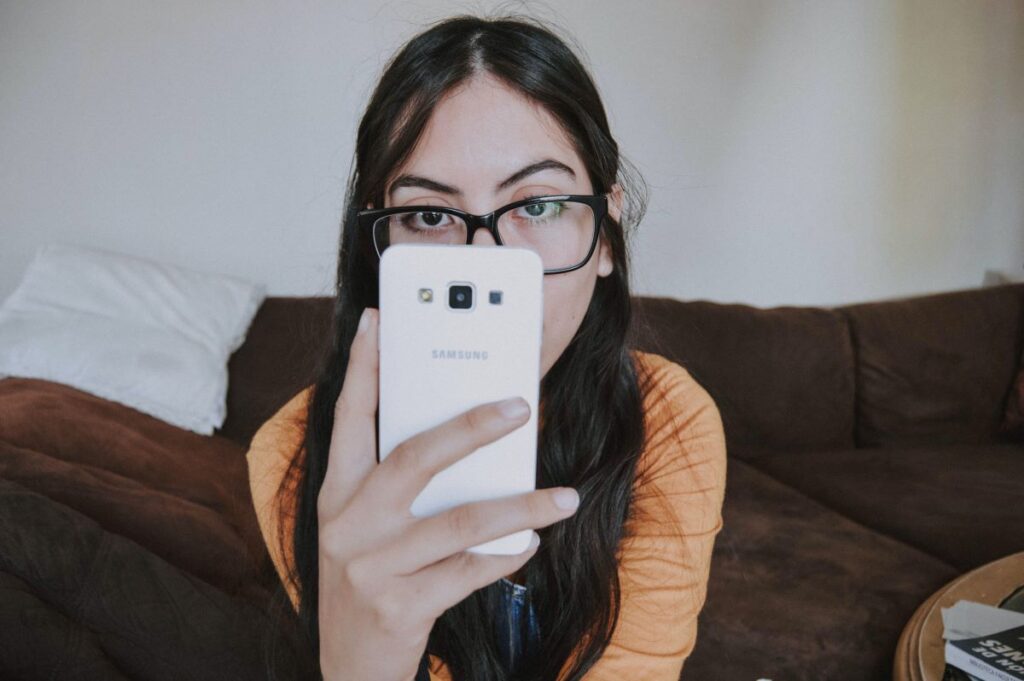
As many as 1 in 8 children and adolescents now have a mental health condition (NHS Digital, 2018). This number is likely to increase in the coming months due to the COVID-19 pandemic. I know that I have personally struggled at times during this uncertain period, and that’s just me. Despite NHS England making it a new priority, and the additional resources and funding dedicated to mental health, children and adolescent mental health services (CAMHS) are still struggling to keep up with this demand for support. Resulting lengthy waiting lists mean that almost three quarters of children and adolescents requiring support are not accessing it (YoungMinds, 2019). Digital interventions could help meet the demand of mental health support when face-to-face is not possible or available.
Around 93% of young people have access to the internet and/or a smartphone (Statista, 2020). Young people deem non-face-to-face alternatives including telemedicine (Bell, 2020), smartphone apps and wearables acceptable and feasible to provide mental health care, particularly for depression and anxiety (Berry, 2020). Some technologies are also recommended such as digital cognitive behavioural therapy (NICE, 2019). However, there are a limited number of children and adolescents using technology for their mental health care. So why aren’t more young people using it? Why are digital interventions not taken up by young people?
Clinicians are often the gatekeepers for digital interventions. They can either facilitate or hinder access to digital alternatives. Indeed, some clinicians do not use or promote digital interventions with their patients because of concerns around safety (Fleming & Merry, 2013) and ensuring the quality of social connection, or therapeutic relationship, which is often linked to improved outcomes face-to-face (Meisel et al 2018). Yet digital interventions for mental health are at least as effective as face-to-face interventions, particularly suicidal thoughts (van Ballegoojien, 2020), sleep (Zachariae, Lyby, Ritterband, & O’Toole, 2016), depression (Merry et al., 2012), anxiety (Firth et al., 2017) and psychosis (Freeman et al., 2017), and are likely to be cost-effective. It may be that clinicians’ technological concerns about safety override the evidence.
A study by Cliffe and colleagues (Cliffe, Croker, Denne, & Stallard, 2019) aimed to explore the attitudes of youth mental health professionals to using technology to understand this area further.

Clinicians are often the gatekeepers for digital interventions. They can either facilitate or hinder access to digital alternatives.
Methods
A cross-sectional design was utilised. All clinicians at Oxford CAMHS (n=320) were invited to complete an online survey via email. The authors asked three specific questions with a mixture of free text and force choice responses.
Do child mental health professionals currently use technology in their everyday practice?
Authors explored the frequency of use (never, every 6 months, every 3 months, monthly or weekly) of different technologies such as smartphone apps, online CBTi and social media.
What are child mental health professionals attitudes towards technology?
Participants were asked to state how strongly they agreed or disagreed to 27 statements informed by previous research. Statements covered professional knowledge and skills, accessibility and availability (e.g. reducing stigma, appeal and continuous day/night access), technology functioning and safety (e.g. privacy, reliability and cost), use in therapy (e.g. concerns about lack of clinician presence) and wider role of technology (e.g. efficacy as a treatment for various disorders).
Do any factors influence child mental health professionals’ attitudes towards using psychology in practice?
Demographic information such as gender, age and years of experience was collected. A further two questions were asked on technological competence (0 = novice to 10 = expert) and perception of technology as helpful (0 = not helpful to 10 = very helpful). Additional free-text boxes were offered for any further thoughts on using technology within CAMHS.
Ethical approval and consent were obtained. Descriptive statistics (proportions and counts) were provided for each question. Simple but clear t-tests or chi-squared t-tests were conducted to explore different between perceived technological competence and usefulness.
Results
One hundred fifty-four CAMHS professionals completed the survey. They were mainly female, under 44 years of age and had 10 or more years’ experience in CAMHS.
1. Do child mental health professionals currently use technology in their everyday practice?
The majority of participants used older technology such as helplines (90.3%), websites (85.1%), smartphone apps (79.9%) and online support (62.7%) rather than newer technology such as virtual reality (7.5%). The most commonly used apps included Blue Ice, Calm Harm and SAM.
2. What is child mental health professionals’ attitude towards technology?
Professional knowledge and skills
Clinicians rated their technology use as competent (m=6.24, SD 1.63) and as helpful (m=6.68, SD= 1.97) yet 60.8% did not know what technology was available. 41.7% did not feel skilled or confident in technology availability.
Accessibility and availability
Most clinicians felt technology is appealing to young people (89.2%) and helpful to engage them in face-to-face interventions (85.0%). The majority also agreed it helped as an early intervention tool (80.8%), accessible (84.2%) and convenient (91.7%).
Technology functioning and safety
Professionals were undecided on issues related to risk/safety (51.7%), privacy (50%) and reliability (47.5%).
Use in therapy
Most clinicians reported that technology was not a solution to the lack of trained therapists (82.7%).
Wider role of technology
The majority agreed that technology use in the prevention of mental health difficulties was important (91.7%) and provides access to other resources (88.3%) and peer support (84.2%).
3. Do any factors influence child mental health professionals’ attitudes towards using psychology in practice?
Age and frequency of technology use significantly influenced attitudes. For example, those aged 18-44 were significantly more competent in using technology [t(149) = 4.26, p<.001) and more likely to rate technology as helpful in clinical practice [t(83.54) = 3.21, p<.001) than their older counterparts. High users of technology were also significantly more likely to be more competent ([t(132 = -2.73, p =.007) and to rate technology as helpful ([t(114.53 = 2.48, p<.015). Older clinicians and low users were significantly less confident in using technology (x2 (1,97 = 10.82, p=.004 and x2 (1,97) = 15.97, p=<0.001, respectively).

Most professionals felt technology is appealing to young people.
Conclusions
The authors concluded that there is a slow uptake of technology within CAMHS. Whilst perceived as appealing and accessible to young people, clinicians have a lack of knowledge about what is available and are apprehensive in promoting its regular use in practice due to safety, privacy and reliability concerns.

These findings suggest a slow uptake of technology within CAMHS.
Strengths and limitations
The authors should be commended for exploring a topic area that can have a direct impact on the potential implementation of digital interventions in CAMHS. The attitudes towards technology use in CAMHS was clearly unknown and the authors have aimed to fill this gap. The paper was a pleasure to read because it was clearly presented and well summarised.
Less than half of the 320 approached took part in the study. It would have been useful if the authors could have provided reasons as to this significant drop-out. Moreover, most questions were also answered by 120 people and not 154 originally reported which is slightly misleading. The sample was also primarily female which could have influenced the findings.
Another limitation, as reported by the authors, is including only one CAMHS service response to the questions, which reduces the generalisation of these findings. Further, this CAMHS service is a Global Digital Exemplar Trust, and so was more familiar with technology than other CAMHS services meaning there is also potential bias. As the authors used an online survey it would be useful to replicate this survey with other CAMHS services across the UK.
The STROBE checklist for cross-sectional studies (STROBE, n.d.), designed to assess quality and transparency of cross-sectional studies, was not used to report results. This information would have strengthened the reporting to give others the confidence in replicating the study.

This paper helps to shed some light on the attitudes towards digital technology use in CAMHS services.
Implications for practice
- There seems to be a disconnect between young people’s desire to access technological alternatives and the clinician’s knowledge, confidence and attitudes towards its successful implementation.
- Clinician’s positivity in using technology is being dampened by technology uncertainty.
- Safety, privacy and reliability concerns must be addressed in the form of training and with a clear message in how to use technology. This may help increase the use and uptake of technology within CAMHS services.
- As gatekeepers, clinicians have a real role to play in making this a reality. This is important because we are living in a “new normal” where digital interventions are needed more than ever before.
- During the last six months of the COVID-19 pandemic, two of my studies (Dewa et al., 2020) (Digital Quality Social Connection as an ‘Active Ingredient’) have highlighted the need for digital support. This is not to say digital interventions should replace face-to-face support, but instead should be provided as an option for early intervention and prevention of mental health deterioration and as part of blended care.

There seems to be a disconnect between young people’s desire to access technological alternatives and the clinician’s knowledge, confidence and attitudes towards its successful implementation.
Statement of interests
None.
Links
Primary paper
Cliffe B, Croker A, Denne M et al. (2020). Clinicians’ use of and attitudes towards technology to provide and support interventions in child and adolescent mental health services. Child and Adolescent Mental Health 25(2) 95-101.
Other references
Bell, I. (2020). Therapy over the telephone: how does it compare to face-to-face? The answer might surprise you… The Mental Elf, June 2020.
Berry, N. (2020). What do young people think about using technology to detect worsening mental health? The Mental Elf, October 2020.
Cliffe, B., Croker, A., Denne, M., & Stallard, P. (2019). Clinicians’ use of and attitudes towards technology to provide and support interventions in child and adolescent mental health services. Child and Adolescent Mental Health, camh.12362.
Dewa, L. H., Crandell, C., Choong, E., Jaques, J., Bottle, A., Kilkenny, C., … Aylin, P. (2020). CCopeY: A Mixed-Methods Co-Produced Study on the Mental Health Status and Coping Strategies of Young People During COVID-19 Lockdown in the UK.
Firth, J., Torous, J., Nicholas, J., Carney, R., Rosenbaum, S., & Sarris, J. (2017). Can smartphone mental health interventions reduce symptoms of anxiety? A meta-analysis of randomized controlled trials. Journal of Affective Disorders, 218, 15–22.
Fleming, T., & Merry, S. (2013). Youth work service providers’ attitudes towards computerized CBT for adolescents. Behavioural and Cognitive Psychotherapy, 41(3), 265–279.
Freeman, D., Sheaves, B., Goodwin, G. M., Yu, L. M., Nickless, A., Harrison, P. J., … Espie, C. A. (2017). The effects of improving sleep on mental health (OASIS): a randomised controlled trial with mediation analysis. The Lancet Psychiatry, 4(10), 749–758.
Merry, S. N., Stasiak, K., Shepherd, M., Frampton, C., Fleming, T., & Lucassen, M. F. G. (2012). The effectiveness of SPARX, a computerised self help intervention for adolescents seeking help for depression: Randomised controlled non-inferiority trial. BMJ (Online), 344(7857).
NHS Digital. (2018). Mental health of children and young people in England, 2017.
NICE. (2019). Depression in children and young people: identification and management. Retrieved November 9, 2020.
Statista. (2020). Children: tablet and smartphone ownership by age UK 2019. Retrieved October 29, 2020.
STROBE. (n.d.). STROBE Statement: Available checklists. Retrieved October 29, 2020.
van Ballegooijen, W. (2020). Digital interventions for suicidal thinking: a tale of two reviews. The Mental Elf, September 2020.
Zachariae, R., Lyby, M. S., Ritterband, L. M., & O’Toole, M. S. (2016). Efficacy of internet-delivered cognitive-behavioral therapy for insomnia – A systematic review and meta-analysis of randomized controlled trials. Sleep Medicine Reviews, 30, 1–10.
Photo credits
- Photo by National Cancer Institute on Unsplash
- Photo by mostafa meraji on Unsplash
- Photo by Bianca Castillo on Unsplash
- Photo by Pascal van de Vendel on Unsplash
- Photo by Thea M. on Unsplash
- Photo by Marc-Olivier Jodoin on Unsplash
